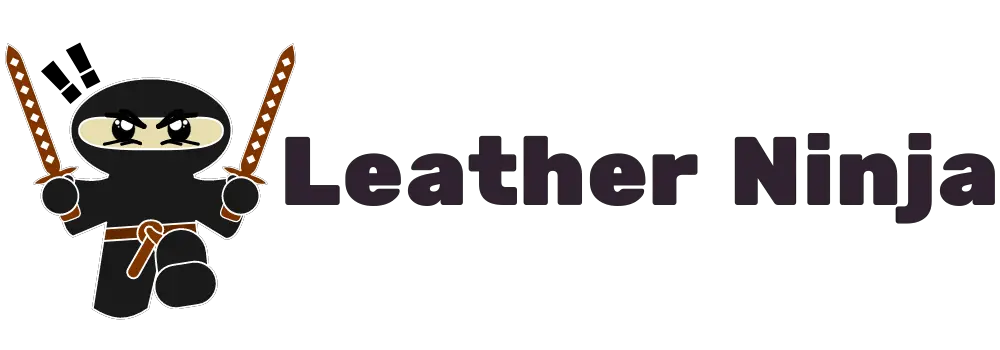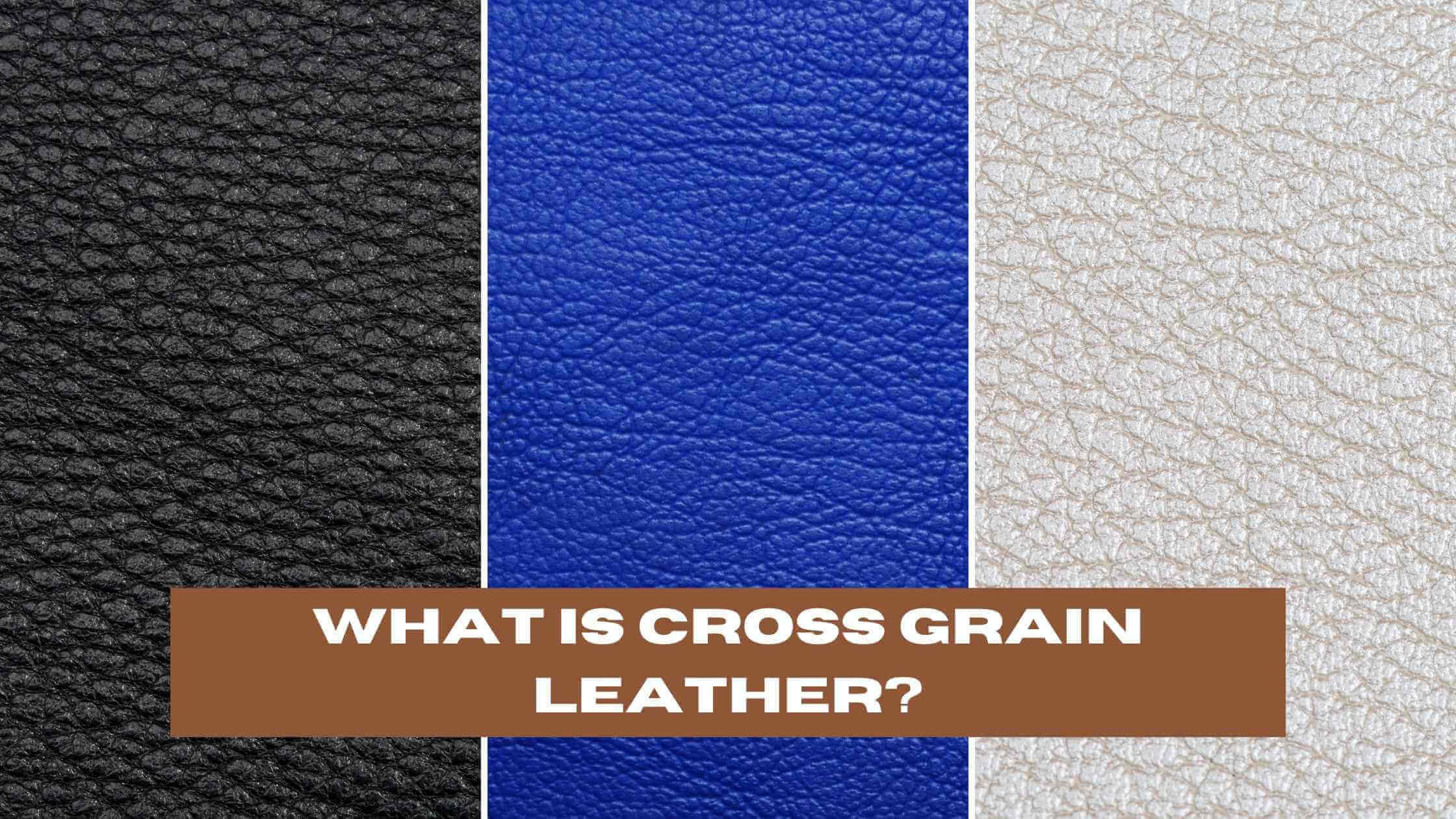If you’re as infatuated with leather as I am, you’ve probably come across a variety of types, each with its unique characteristics and charm. Today, I’d like to share some insights about one of the lesser-known but equally intriguing types: cross grain leather.
Cross grain leather is a type of leather that is cut diagonally to create a distinctive wavy texture, which not only hides the material’s natural imperfections but also offers unique thickness and durability compared to most other types of leather. This process results in a durable and visually unique material that retains its aesthetics even under challenging conditions.
Understanding Cross Grain Leather
When you explore the world of leathers, cross grain leather stands out for its distinct texture and durability.
Definition and Characteristics
Cross grain leather is a uniquely processed material known for its embossed texture that exhibits a diagonal or crisscross pattern. This particular grain pattern is achieved through specific treatments like sanding down natural imperfections and embossing a uniform pattern onto the leather. These processes improve the visual appeal and uniformity, masking any uneven grain distribution. Characteristics of cross grain leather include:
- Visual Appeal: The consistent and intentional grain imparts a sophisticated look.
- Durability: Treatment of the leather surface enhances its resistance to wear.
- Texture: The resulting texture can vary but generally includes a distinctive tactile feel.
History and Evolution
Historically, leather has been an evolving material with various treatments developed to enhance its qualities and appearance. Cross grain leather was created to offer high durability while also providing an aesthetically pleasing surface free from the natural imperfections of the hide. Over time, techniques have improved, resulting in cross grain leather being a popular choice for products where both quality and visual appeal are sought after. Through its evolution, this leather has found a unique place in markets demanding authenticity with an eye for detail.
Types and Comparisons
In this section, you’ll learn about the traits that distinguish cross grain leather from other leather types and gain insight into its place within the leather hierarchy.
Cross Grain vs. Full Grain Leather
Full Grain Leather is the highest quality of leather available. It retains the complete texture of the animal’s hide, showcasing all natural imperfections and the richest patinas over time. In contrast, Cross Grain Leather is a treated form of leather where the surface has been embossed, often to create a uniform appearance that can mask natural blemishes.
- Durability: Full grain leather is renowned for its superior durability and longevity.
- Appearance: Cross grain leather provides a more consistent look due to the embossing process.
Cross Grain vs. Top Grain Leather
Top Grain Leather represents a step down from full grain leather, having been sanded to remove imperfections. This grants it a more uniform finish, but some natural qualities are lost. Cross Grain Leather, as mentioned, also undergoes significant processing, embossing specifically, which can sometimes give the leather a similar level of uniformity.
- Texture: Top grain leather is smoother and more uniform than full grain.
- Feel: Cross grain may possess a varied texture due to its embossing which can mimic more expensive leathers like Saffiano.
Other Variants of Leather
Besides full and top grain, leather can come in several other forms:
- Bonded Leather: Built from leather leftovers and not as durable or high-quality as cross grain.
- Genuine Leather: A catch-all term often associated with lower-quality products, but cross grain falls into this category due to its real leather origin.
- Corrected Grain Leather: Similar to top grain leather, in which the surface is sanded and then embossed.
Pebbled Leather uniquely has a raised, rounded texture and may be naturally occurring or machine-embossed. Embossed Leather like cross grain can imitate other textures and patterns, providing you with a luxury feel at a more affordable price. Quality across these types varies, with full grain at the peak for durability and value, while the others offer different combinations of affordability and aesthetic appeal.
Benefits and Limitations
As you explore the world of leathers, understanding the benefits and limitations of cross grain leather ensures you make an informed decision.
Advantages of Cross Grain Leather
Durability and Longevity: Cross grain leather is recognized for its exceptional durability. Thanks to a surface that’s usually been sanded and then embossed, this leather can withstand considerable wear and tear, making it a practical choice for items you use daily.
- Resistance to Stains and Scratches: The protective coating on cross grain leather doesn’t just extend its life; it also adds a layer of resilience against unsightly marks. Your cross grain leather items will typically look unscathed even after encounters that would scratch or stain other materials.
Maintenance: Caring for cross grain leather is relatively easy. Cleaning it simply requires a mild soap and a soft cloth, followed by conditioning with a quality leather conditioner to maintain its suppleness.
- Water-Resistant: An inherent ability to resist moisture makes cross grain leather advantageous for those who frequently find themselves in different weather conditions.
Potential Drawbacks
Texture and Naturalness: In the process of modifying the leather’s surface, some of its natural texture is lost. If you’re a fan of the unaltered, organic patterns found in other leather types, cross grain might feel less authentic.
- Care and Maintenance: While easy to clean, regular maintenance is still crucial. Neglecting the use of leather conditioner can lead to the material drying out over time, which detracts from its overall longevity.
Eco-friendliness: It’s important to note that the process of creating cross grain leather typically involves chemicals for the embossing and coating. This might not align with eco-friendly preferences.
Maintenance and Care
Proper care is essential to maintain the integrity and appearance of your cross grain leather items. By following the correct procedures, you can ensure that your leather remains long-lasting and resilient.
Cleaning Techniques
To clean your cross grain leather, start by wiping down the surface with a dry, soft cloth to remove any loose dirt. For more persistent spots or stains, use a mild soap along with a damp cloth. Be sure to test any cleaning method on an inconspicuous area first to prevent unwanted damage. Here’s a brief guide:
- Dry Cloth: Lightly brush the surface.
- Mild Soap: Use sparingly with water on a soft cloth.
Never saturate the leather and always let it air dry naturally away from direct heat.
Preservation and Storage
Leather Conditioner: Apply a quality leather conditioner once every few months to keep the leather supple and prevent drying or cracking.
Storage: Ensure your cross grain leather products are stored in a cool, dry place to prevent peeling and flaws caused by humidity. Keep them away from direct sunlight as this can lead to fading.
To further enhance its longevity, consider using a water-resistant protective coating, tailored for leather, to guard against spills and stains. Follow these specific steps to care for your cross grain leather, and you’ll enjoy its durability and style for years to come.
Cross Grain Leather in Fashion and Lifestyle
Cross grain leather offers a distinctive texture and pattern that has been a unique addition to both fashion items and home decorations. You’ll find it enhancing the style and durability of various products that you use daily.
Use in Accessories and Apparel
Accessories such as wallets, belts, and handbags benefit from cross grain leather’s resilience and style. Cross grain leather gives shoes a durable finish while maintaining a level of sophistication.
- Handbags: Recognized for their adaptability, cross grain leather handbags are crafted not only for their aesthetic appeal but also for their robustness.
- Belts and Wallets: Praised for their ability to withstand wear, these accessories add both function and flair to your wardrobe.
Every stitch in a cross grain leather item underscores a commitment to craftsmanship, making these goods enduring additions to your fashion ensemble.
Furniture and Home Decor
Cross grain leather finds an esteemed place in furniture design, where its texture contributes to both the visual and tactile experience.
- Couches and chairs upholstered in cross grain leather offer longevity and grow more attractive over time, developing a characteristic patina.
- In home decor, cross grain is often a mark of authenticity; it’s a testament to the value embedded in the material’s versatility and luxury.
Luxury and Branding
Within the luxury goods sector, brands like Coach have incorporated cross grain leather into their designs. This signifies a blend of sophistication and practicality.
- Luxury Products: These products emphasize the material’s quality and the finesse of their stitching, enhancing the item’s overall value.
- Bags to Shoes: Cross grain leather elevates everyday items into the realm of luxury, making a clear statement about the wearer’s appreciation for high-quality materials.
In the fashion industry, your choice of cross grain leather pieces showcases a penchant for luxury and a keen eye for style. This marks your own signature in the world of high-end fashion.
FAQs on Cross-Grain Leather
1. What exactly is cross-grain leather?
It is embossed leather to form a grain pattern different from its natural one. This process helps mask any surface blemishes, yielding a high-quality and durable finish.
2. How is cross-grain leather created?
The embossing procedure involves exerting high pressure on the leather, altering its natural grain pattern. This modification doesn’t just provide a distinctive appearance but also enhances the leather’s durability.
3. Differences among cross-grain, top-grain, and full-grain leather?
Full grain retains the complete natural grain pattern and is often hailed as top-tier leather. Top grain, meanwhile, undergoes surface refinishing. Cross-grain, with its embossed grain pattern distinct from the natural one, serves to hide imperfections.
4. Cross-grain leather products?
Given its durability, cross-grain leather finds its way into a plethora of items like bags, wallets, belts, shoes, and even furniture.
5. Cross-grain vs. Pebbled leather?
While both are embossed types, pebbled leather mimics the appearance of tiny pebbles. Cross-grain features a more defined crisscross pattern. Choosing between the two often boils down to personal aesthetic preferences.
6. Is cross-grain leather of high quality?
Absolutely. The embossing process elevates its quality by masking imperfections, resulting in a smooth yet robust surface.
7. Special care for cross-grain leather?
Like any leather I’ve worked on, it appreciates some TLC. Using leather conditioner keeps it looking splendid. But, always sample any product on a small section first.
8. Cross-grain as top grain leather?
Indeed, cross-grain is embossed on the hide’s top layer, classifying it under top grain leather.
9. Cost of cross-grain leather?
Prices fluctuate based on the base leather’s quality and the embossing complexity. Although pricier than some leathers, it’s often more affordable than full-grain.

